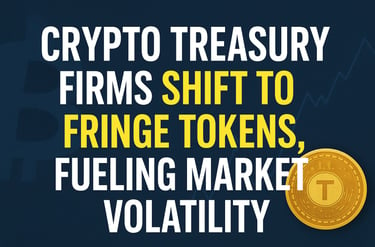Crypto Treasury Firms Shift to Fringe Tokens, Fueling Market Volatility
Publicly-traded crypto treasury firms pivot to obscure, low-liquidity tokens, raising volatility and investor risks.
Raja Awais Ali
11/10/20252 min read


Crypto Treasury Firms Shift to Fringe Tokens, Fueling Market Volatility
In recent years, cryptocurrencies such as Bitcoin and other major coins dominated headlines and corporate treasuries. However, a new trend has emerged: publicly-traded firms that maintain digital asset treasuries are increasingly moving away from large, established cryptocurrencies toward smaller, lesser-known tokens — often called “fringe” or low-liquidity tokens. This shift is driving notable volatility across markets.
The backdrop to this change is a combination of a saturated large-coin market and waning sentiment around major holdings like Bitcoin and Ether. Supported by crypto-friendly policies and inspired by leading firms’ success in the space, the number of Digital Asset Treasury (DAT) companies has risen sharply, with a combined market capitalization of around $150 billion — more than triple compared to last year.
Why are these firms chasing fringe tokens?
Search for higher returns: When large crypto assets stagnate or decline, companies seek alternative avenues to generate gains.
Upside potential of smaller tokens: Low-liquidity, lesser-known tokens can offer high returns, though the risk is far greater.
Funding via private placements: Many firms raise capital through private investment in public equity (PIPE) or discounted share offerings to purchase tokens, which can pressure shareholders and affect stock prices.
Risks and implications
Liquidity risk: Fringe tokens are prone to dramatic price swings, especially in market downturns, exposing treasury firms to significant losses.
Equity risk: Several DATs already trade below the net asset value (NAV) of their crypto holdings. Sharp declines in token value can simultaneously impact the company’s crypto assets and stock price.
Systemic volatility: Because these firms hold meaningful shares of major digital assets, their trading activity can ripple across broader crypto markets, amplifying volatility.
Guidance for investors
Investors should exercise caution:
Assess which tokens the firm is acquiring and their liquidity.
Examine the firm’s funding sources, especially reliance on private placements or aggressive dilution.
Evaluate whether the company has a credible strategy beyond simply accumulating tokens.
While chasing high returns in fringe tokens may seem tempting, the downside is both steeper and faster.
Conclusion
Crypto treasury firms are entering a new chapter — moving from “safe-bet” major coins into exotic, less-regulated tokens. The potential upside may appear significant, but volatility and risk for both companies and investors are elevated. This trend is likely to influence not only individual firms but the broader digital-asset marketplace. Bloggers, investors, and market observers should monitor this development closely.